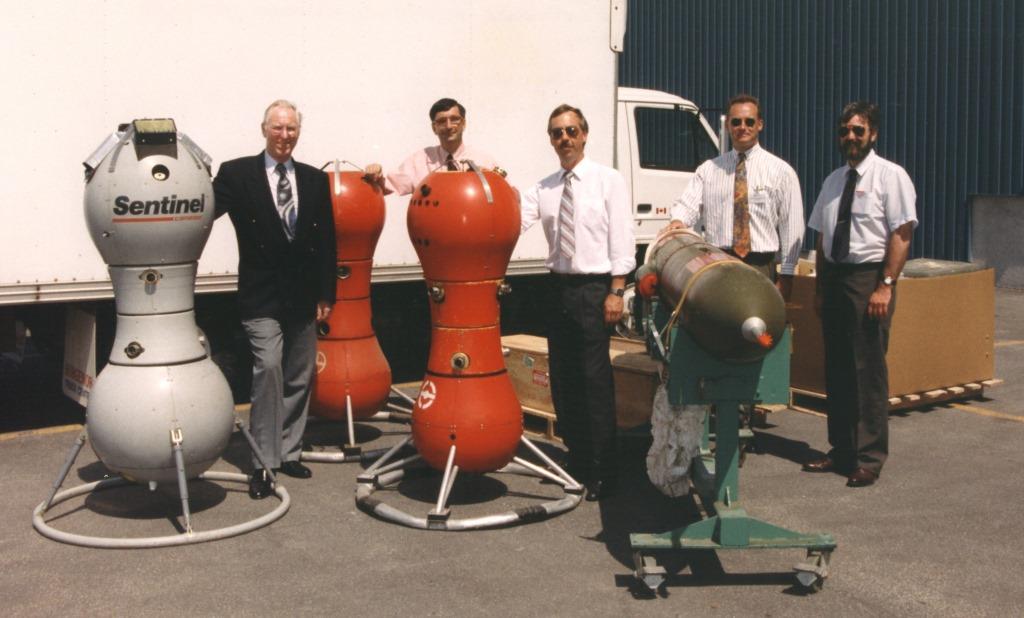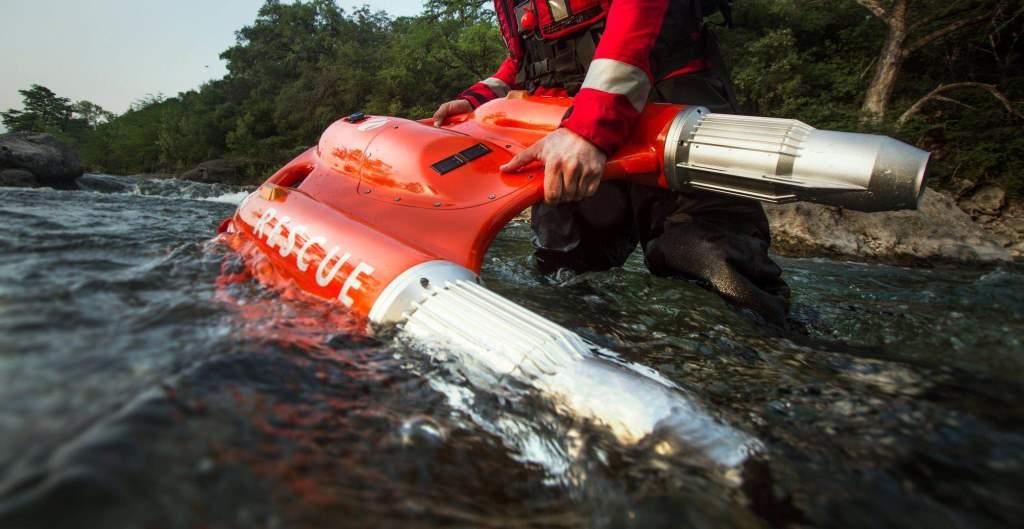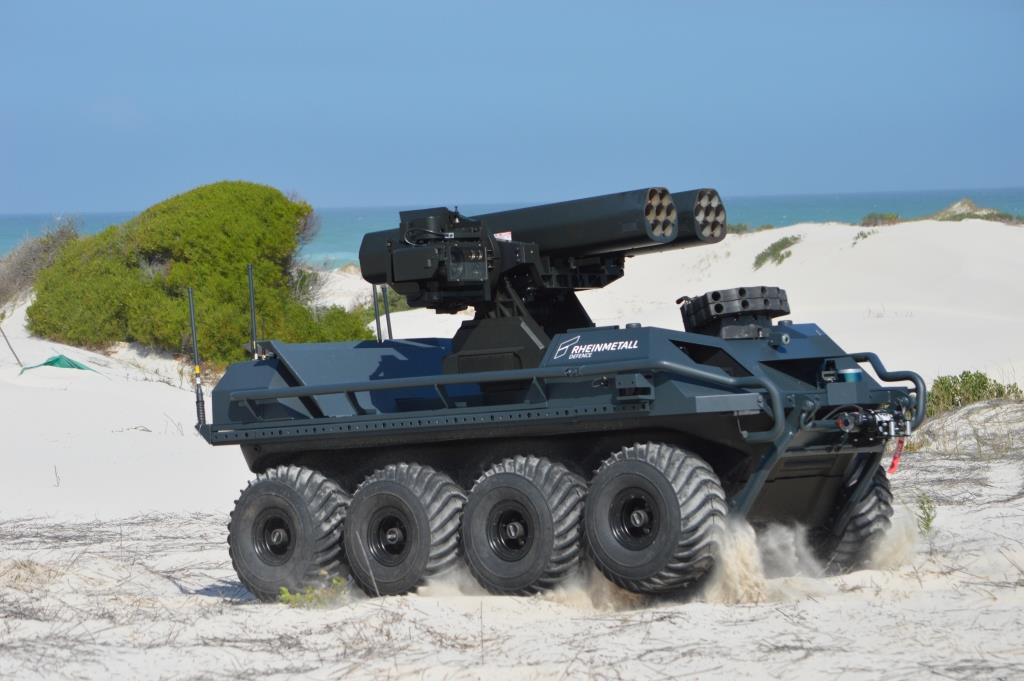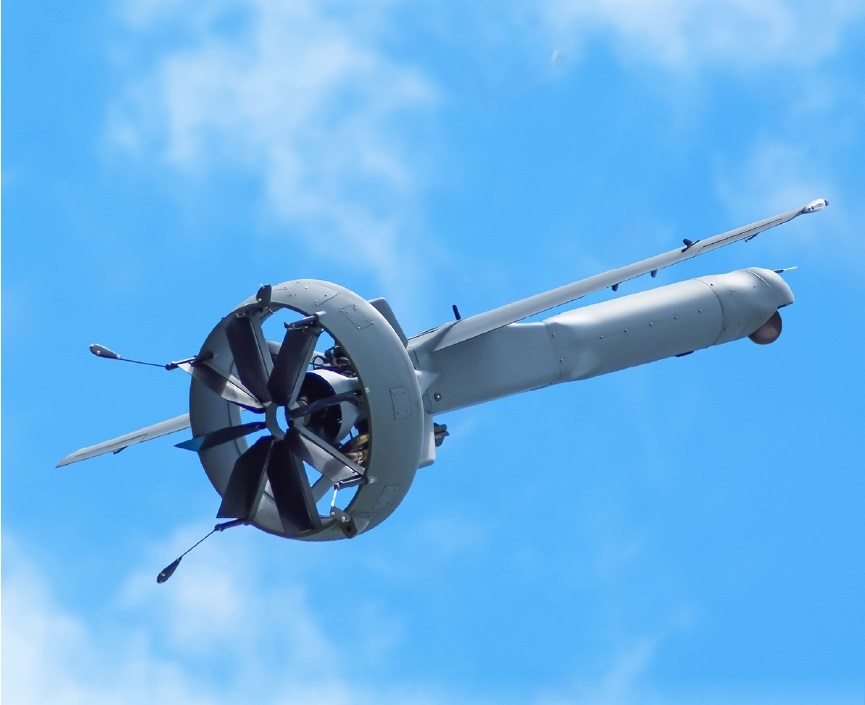UNMANNED SYSTEMS
BY JAMES CARELESS
RPAS to Provide Unprecedented Aerial Surveillance
As UAS Systems Go Mainstream
 There was a time when unmanned systems were technological novelties. But no longer: Whether it is a sophisticated UAV (unmanned aerial vehicle), a water-based rescue vehicle, or a mobile ground-based weapons platform, unmanned systems are going mainstream in Canada – especially for defence applications.
There was a time when unmanned systems were technological novelties. But no longer: Whether it is a sophisticated UAV (unmanned aerial vehicle), a water-based rescue vehicle, or a mobile ground-based weapons platform, unmanned systems are going mainstream in Canada – especially for defence applications.
The proof can be found in the number of unmanned systems being deployed or proposed for Canadian military missions. For our annual Report on Unmanned Systems, we have taken a close look at some of the key programs.
CANADA A PIONEER IN UNMANNED TECHNOLOGY
Perhaps the reason unmanned systems appeal to Canadians is because we tend to implement advanced technological solutions whenever we can. Space-based satellites are a good example of this tendency: In 1962 Canada launched the Alouette 1 ionospheric research satellite, making us the third country in the world to orbit a satellite after the Soviet Union (now Russia) and the United States.
The same “can do” attitude applies to Canada and unmanned systems. According to ‘A History of Unmanned Aviation In Canada’ published by aerospace firm MDA (authored by Andrew Carryer in 2008), Canadair developed the CL-89 surveillance drone in 1963 with full production being achieved in 1966.
This CL-89 looked like a missile, and indeed it was fired from a ground-based launcher using a booster rocket. But once aloft, the CL-89 flew like an aircraft powered by a small turbojet engine.
“During a typical mission, a drone would launch and fly a pre-programmed route, its sensors and cameras would collect information, and then the system would return to a recovery site and land with the assistance of a parachute,” wrote Carryer. “The system was manufactured in Montreal for the armies of Canada, the United Kingdom, and the Federal Republic of Germany.”
A version of the CL-89 with more range and payload capacity – dubbed the CL-289 – was built in the 1970s. It saw service with French and German forces in Bosnia and Kosovo during the 1990s.
Canadair (later Bombardier) also developed a group of rotary wing drones including the CL-227 ‘Sentinel’, CL-327 ‘Guardian’ and the CL-427 ‘Puma’. Unlike the CL-89/CL-289, these were capable of remotely-controlled, vertical take-off and landing (VTOL) flight.
“Canada has always been a pioneering nation when it comes to unmanned systems,” observed David Willems, VP Business Development & Strategy at UMS SKELDAR. His company’s UMS SKELDAR V-200 UAV is a key platform for Intelligence, Surveillance, Target Acquisition and Reconnaissance (ISTAR) deployments.
“With thousands of kilometers of infrastructure to survey and maintain for the Energy sector alone, the opportunities for services companies using unmanned vehicles are commensurate,” Willems said. As CDR has reported, UAVs are now government-certified to fly beyond the horizon to inspect pipelines and other oil & gas infrastructure.
A WEALTH OF OPPORTUNITIES
Canada’s appreciation of unmanned systems for civilian and military purposes opens up a wealth of business opportunities. This applies to support services as well as to drones themselves.
“The Canadian market should be strong, with our huge geography driving unmanned applications,” Paige Cutland, told CDR. Cutland is VP Sales & Marketing with Kongsberg Geospatial, a producer of military command and control software for over 30 years. This observation certainly applies to Kongsberg Geospatial. Along with Larus Technologies and the Civil Air Search and Rescue Association of Canada (CASARA), the company has been selected by Public Safety Canada to enhance drone performance in Search and Rescue (SAR) missions using geospatial software, artificial intelligence, and machine vision software.
Overall, government and private sector demand for Canadian UAV-based services is pushing the technological envelope, said Canadian UAVs’ President and Founder Sean Greenwood. As a result of this demand, “unmanned vehicle weight classes and their reach/endurance are going to increase,” Greenwood told CDR. As well, “… in the current RFPs that are coming out, there's a lot of emphasis on vehicle capability.”
“The Canadian government has been the real game-changer pushing the way ... for larger remotely piloted aircraft systems (RPAS) for various missions,” said James Castle, President/Founder of Terranova Defense Solutions. “The Canadian Navy and Canadian Army are but a few looking for many mission specific systems to fulfill the void of the unmanned and autonomous systems for a variety of mission specific needs.”
ISTAR CHANGES THE GAME
One of the most game-changing unmanned system deployments is the RCN/CANSOFCOM’s ISTAR program, using UAVs based on the UMS SKELDAR V-200. The $51 million contract to provision ISTAR was awarded to QinetiQ in May 2019, along with its partners UMS SKELDAR, Canadian UAVs, L3 WESCAM, and Leonardo.
Designed as a maritime platform, the ISTAR UAVs can be deployed from and controlled by ships conducting domestic and international missions. They can also provide over-the-horizon surveillance using a range of onboard sensors, including an Active Electronically Scanned Array (AESA) radar and Electro-optic infrared (EO/IR) camera.
“UMS SKELDAR, a joint venture between Saab and UMS AERO Group, is Europe’s leading provider of Remotely Piloted Aircraft Systems that have been developed to meet the most complex challenges,” UMS SKELDAR’s David Willems told CDR. “The SKELDAR V-200 can fly for more than five hours, and its two-stroke engine configuration from Hirth Engines – alongside efficient maintenance schedules and ease of access to engine compartments – means that it can stay longer in the air before any need for overhaul.”
According to Willems, the V-200 supports a wide range of applications such as Reconnaissance, Identification, Target Acquisition and Electronic Warfare. A number of Commercial Off-The-Shelf (COTS) high resolution Electro-Optical/Infrared (EO/IR), Synthetic Aperture Radar (SAR) and Electronic Warfare (EW) sensors are available to maximize this drone’s capabilities.
“Our first major success in this sector was with the German Navy in 2018,” said Willems. “The SKELDAR V-200 was selected to provide UAV reconnaissance capability from Corvette KC-130 class ships. The deal includes two V-200 platforms, integration of the system into the ship, a spare parts package and training of ship-borne operators and maintenance personnel. The German Navy has recently begun at-sea tests of the platform as part of this contract.”
Most recently, the SKELDAR V-200 was selected for a naval mine countermeasures capability replacement program led by Belgium Naval & Robotics – a consortium including Naval Group and ECA Group – for the Belgian and Royal Netherlands navies. “The deal is the first to utilize the Toolbox concept, which incorporates aerial, surface, and underwater drones, with deliveries of the SKELDAR V-200 expected to start in 2023,” Willems said.
RPAS VALUED AT OVER $1 BILLION
The Canadian government’s Remotely Piloted Aircraft System (RPAS) procurement is one of the most anticipated unmanned systems projects in the country. Whichever UAV is selected, the RPAS procurement will provide unprecedented aerial surveillance capabilities to the Royal Canadian Air Force. The RPAS contract will be worth anywhere from $1 to $5 billion, once all acquisition costs are factored in.
The two UAVs approved to compete in the RPAS Procurement are the Israeli-built Heron TP fielded by Team Artemis (L3Harris and Israel Aerospace Industries), and the MQ-9B SkyGuardian proposed by Team SkyGuardian (General Atomics Aeronautical Systems, CAE, MDA and L3 WESCAM; with US government support).
The Heron TP is based on IAI’s Heron 1 (a.k.a. CU-170), three of which were flown by the Canadian Armed Forces in Afghanistan under a leasing contract. The MQ-9B SkyGuardian is General Atomics’ most advanced UAV and it has already been selected by the UK, Belgium and Australia. GA’s MQ-9 Reaper has seen service with the US Air Force and NATO forces.
At press time, both RPAS bidders were waiting for the Canadian government to issue a draft Request for Proposal (RFP) this Fall, followed by a formal RFP sometime in 2021. After the two bids are analyzed, Ottawa is scheduled to award the RPAS contact to a winner in 2022/23. The first RPAS drone is expected to be received sometime in 2024/25, with initial deployment starting in 2025/26. Full operational capability is scheduled to occur in 2029/30, with Canada’s new UAVs expected to serve for at least 25 years.
THE INNOVATIVE V-BAT DRONE
Imagine a drone that can be carried in shipping cases to any location and reassembled in minutes, launch and land vertically using its tail-mounted ducted fan engine, and then fly horizontally as a winged drone. This includes the ability to switch from vertical hover mode to horizontal flight and back again, and to hover in place over targets to capture images.
This is now possible with the gasoline-powered V-BAT and the Electric V-BAT UAVs; both made by Martin UAVs.
“The V-BAT is disruptive technology,” said Heath Niemi, Martin UAV's Vice President of Global Sales and Development. He told CDR, “It’s the only one of its kind that can hover and then easily transition to forward flight as a fixed-wing drone.”
Moreover, the V-BAT doesn’t need a runway or recovery system: It can be transported wherever it is needed using a pickup truck, mini-van, or helicopter; assembled by a two person crew in minutes; flown, recovered, and then packed back into its case for transport elsewhere.
At present, Martin UAV has won an Other Transaction for Prototype Agreement with the US Marine Corps Systems Command. Under the contract, Martin UAV will help the Marines develop Tactics, Techniques and Procedures for V-BAT operations in an operational environment over an extended period.
The V-BAT has also recently been deployed aboard a US Coast Guard cutter in August 2020, to assess how medium-range VTOL UAVs might be used to support Coast Guard operations, including Beyond Visual Line of Sight operations.
In Canada, Martin UAV has partnered with Kongsberg Geospatial to craft an ISTAR solution for the RCN/CANSOFCOM. The solution combines Martin UAV’s V-BAT with Kongsberg’s IRIS UxS airspace awareness/mission management system to create an end-to-end mission data collection and analysis capability for Beyond Visual Line of Sight (BVLOS) operations. “We have a demonstration set up for this solution next year, which is being sponsored by the Canadian coast guard,” Niemi told CDR.
MARINE DRONES FROM TERRANOVA
When most people think of unmanned systems, they think of UAVs overhead. But unmanned systems also have their place in the water -- as proven by Terranova Defense Solutions’ lineup of marine drones for SAR and lifesaving missions.
The first category is covered by Terranova’s TN75 Protector SAR Drone Ship. The Protector is a 1000 kg Unmanned Surface Rescue Vehicle (USRV) equipped with comprehensive searching, data, communication and rescue modules, allowing it to fulfill maritime surveillance and rescue operations. The ship’s photoelectric pod enables TN75 to search at night and take high resolution photos for evidence.
“Using LTE communication, TN75 can interact with the base station within 15 kilometers and send back videos and data in real-time,” said James Castle. He told CDR, “The TN75 can be deployed with rescue equipment like ejectable life rafts and a remote-controlled life bed or lifebuoy to conduct rescuing missions in different water environments.”
Terranova’s TN75 can autonomously team up to conduct massive-scale search and rescue missions to locate victims. It uses a high-speed water jet motor that can reach a maximum speed of 30 knots, allowing for quick emergency response times.
The lifesaving category is handled by Terranova’s Dolphin One, a self-powered Unmanned Surface Rescue Vehicle (USRV) that can be used by lifeguards, first responders, SAR helicopters, and ships in all marine environments. Slightly larger than a swimmer’s flutter board, “… the Dolphin One is controlled by a simple remote controller, which is very easy to operate for first-time users,” said Castle.
“It is easily seen with its bright orange and reflective decals and two high penetration flashing fog lights, which make this water safety drone highly visible in any type of weather, day or night.” The Dolphin One has a maximum speed of 10 knots/15 kph; a safe propeller system and the ability to carry up to two people at the same time.
“We have sold the Dolphin One in Canada, United States, the Caribbean and in the South Pacific,” Castle told CDR. “We have also started locating resellers abroad and slowly are moving the product globally.”
RHEINMETALL ARGUS SYSTEM
The capabilities that unmanned systems brings to aerial and water-based operations have been harnessed by Rheinmetall Defence for its unmanned Mission Master multipurpose ground vehicles (A-UGV). These armored vehicles, developed in Canada, can fulfill a wide range of missions such as CBRN detection, firefighting, MEDEVAC, reconnaissance, surveillance operations, and tactical over watch.
The Mission Master interconnects with Rheinmetall’s Argus soldier data platform and Rheinmetall Command and Control Software, which can be installed in any user’s battle management system.
The unmanned Rheinmetall Mission Master can perform dangerous tasks on the battlefield without putting humans at risk. The vehicle can also be weaponized to provide close fire support to dismounted troops. According to the company, this capability, “…was demonstrated for the first time at the Ammunition Capabilities Demonstration 2019 in South Africa with the Rheinmetall Fieldranger Multi weapon station and Thales 70 mm rocket launchers in hot shot.
The remotely controlled system operated in a fully digitized scenario and fired a salvo of 14 rockets, delivering 60 kg of explosives in 1.6 seconds ... The Mission Master – Fire Support can also be mounted with 50 mm weapon systems, .50 cal. machine guns, or 40 mm grenade launchers.”
The stories above underline the point made at the outset of this article: Unmanned systems are going mainstream in Canada. That said, the adoption of this technology could be happening faster, were there not obstacles in the way.
GOVERNMENT MUST CUT RED TAPE FOR DRONES
Red tape is tying up the deployment of unmanned systems. “The Canadian market is more being held back by slow regulatory pace than being driven forward by government initiatives or significant procurements,” commented Kongsberg Geospatial’s Paige Cutland.
And UMS Skeldar’s David Willems concurred, saying the problem is global. “Currently, the regulatory landscape for operating UAVs is limited with many organizations looking to the manned aviation standards for guidance,” he told CDR. To change the situation, “Governments across the world will need to assist in the development of the regulatory frameworks that operate around the UAV industry. (Instead) Worldwide civil aviation authorities have been playing catch-up, and in some cases legislation has been seen as potentially strangling research and development.”
Improving the procurement process could help cut red tape, said Terranova’s James Castle. Specifically, “The government in the unmanned systems sector could boost the industry by possibly shortening the Request for Information (RFI), Request for Quotation (RFQ) and Request for Proposal (RFP) bidding cycle process from its current four-seven year decision cycle,” Castle observed.
“Another area where the government can boost this industry is to make it easier and quicker for approved unmanned systems providers to receive grants and ITB funds, so that they can solve real-time problems for the military.”
Public mistrust is another obstacle standing in the way of unmanned systems adoption. “Outside of the laws of physics, the main limiting factor for UAVs is our perception of them and how we accept their capability,” said Castle. “The government needs to help society to trust in UAVs and their capabilities, in order for this industry to thrive further.”
DRONES IN THE AGE OF COVID-19
Ironically, COVID-19 itself may be changing the public’s negative perception of unmanned systems – for the better.
The reason? “The pandemic has arguably enhanced the growth of the UAV market,” said Willems. “Before March 2020, the term ‘pandemic drone’ was relatively unheard of. Now, we are familiar with news of UAVs playing a critical role in fighting the pandemic, such as disinfecting public spaces and delivering medical supplies.”
James Careless is CDR’s Ottawa Bureau Chief


